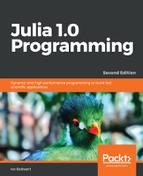You can view the binary representation of any number (integer or float) with the bitstring function, for example, bitstring(3) returns "0000000000000000000000000000000000000000000000000000000000000011".
To round a number, use the round() function which returns a floating point number. All standard mathematical functions are provided, such as sqrt(), cbrt(), exp(), log(), sin(), cos(), tan(), erf() (the error function), and many more (refer to the URL mentioned at the end of this section). To generate a random number, use rand().
Use parentheses ( ) around expressions to enforce precedence. Chained assignments, such as a = b = c = d = 1, are allowed. The assignments are evaluated right-to-left. Assignments for different variables can be combined, as shown in the following example:
a = 1; b = 2; c = 3; d = 4 a, b = c, d
Now, a has a value of 3 and b has a value of 4. In particular, this makes an easy swap possible:
a, b = b, a # now a is 4 and b is 3
Like in many other languages, the Boolean operators working on the true and false values for and, or, and not have &&, ||, and ! as symbols, respectively. Julia applies a short-circuit optimization here. That means the following:
- In a && b, b is not evaluated when a is false (since && is already false)
- In a || b, b is not evaluated when a is true (since || is already true)
The operators & and | are also used for non-short-circuit Boolean evaluations.
Julia also supports bitwise operations on integers. Note that n++ or n-- with n as an integer does not exist in Julia, as it does in C++ or Java. Use n += 1 or n -= 1 instead.
For more detailed information on operations, such as the bitwise operators, special precedence, and so on, refer to http://docs.julialang.org/en/latest/manual/mathematical-operations/.
